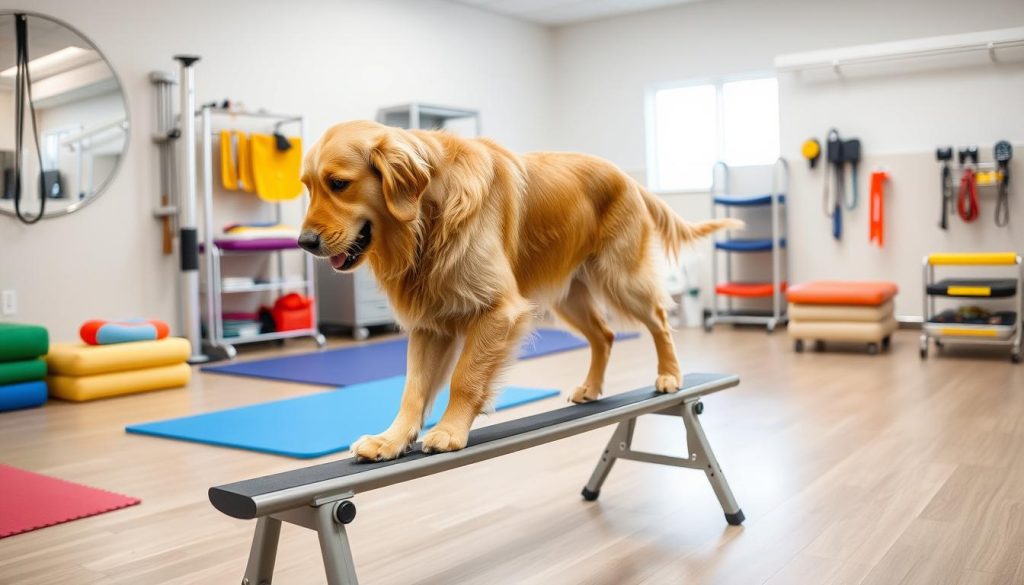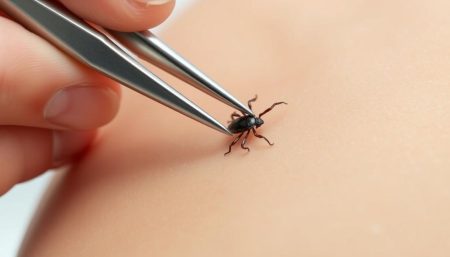Dogs recovering from knee surgery need special care to move again. Physical therapy centers for dogs after knee surgery have programs made just for them. These clinics give expert care to help dogs heal and get back to their active lives.
Veterinary medicine has seen more dedicated rehabilitation facilities. These places focus on care after canine knee surgeries. They have trained staff who know what recovering dogs need.
With the latest equipment and plans made just for each dog, these clinics aim to make recovery faster and better.
Physical therapy centers for dogs after knee surgery are key in the healing process. They offer services to lessen pain, improve function, and prevent future injuries. As more pet owners see the value of professional rehabilitation, these clinics are becoming more popular and important.
Understanding Canine Knee Surgery and Rehabilitation Needs
Canine knee surgeries help dogs move better and live better lives. Pet owners should know about pet orthopedic physical therapy for the best recovery.
Common Types of Dog Knee Surgeries
Dogs often need knee surgeries to move better. The most common surgeries are:
- Cruciate ligament repair
- Patellar luxation correction
- Meniscus repair
Each surgery fixes a different knee problem. They aim to make the knee work right again and stop pain.
Professional Rehabilitation Essentials
Professional rehab is key for dog ACL surgery recovery. It helps avoid problems and ensures healing. Benefits include:
- Faster recovery time
- Improved range of motion
- Reduced risk of re-injury
- Pain management
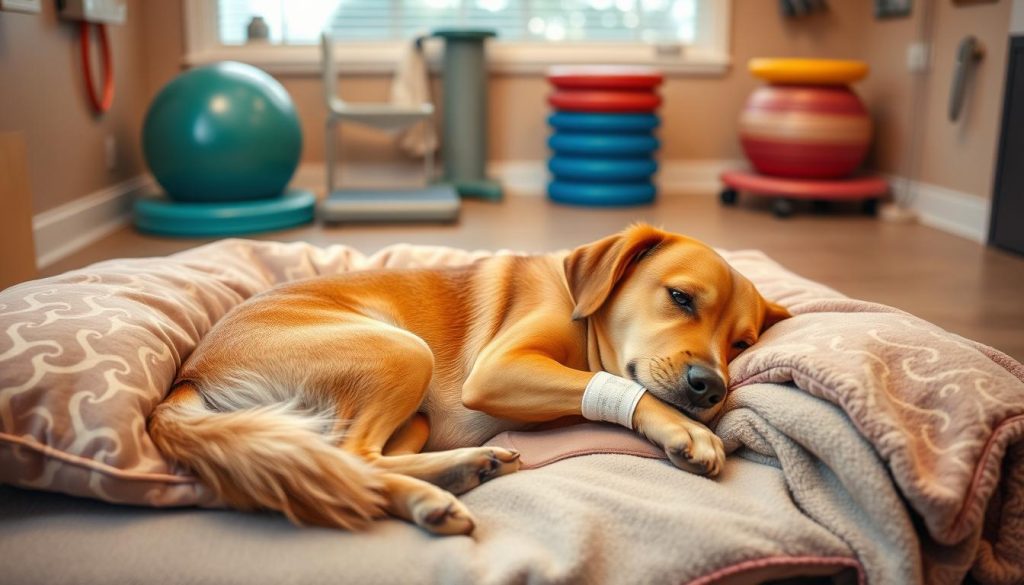
Post-Surgery Recovery Timeline
The recovery time after knee surgery varies. But, a general timeline helps set expectations:
| Recovery Stage | Duration | Key Activities |
|---|---|---|
| Initial Recovery | 1-2 weeks | Rest, wound care, pain management |
| Early Rehabilitation | 2-6 weeks | Gentle exercises, controlled movement |
| Progressive Rehabilitation | 6-12 weeks | Increased activity, strength building |
| Full Recovery | 3-6 months | Return to normal activities |
Knowing these stages helps pet owners support their dogs. It ensures the best outcome for their furry friends.
Physical Therapy Centers for Dogs After Knee Surgery
Physical therapy centers for dogs provide special care for dogs after knee surgery. These places have the latest tools and experts in dog rehab. They focus only on helping dogs get better from surgeries and injuries.
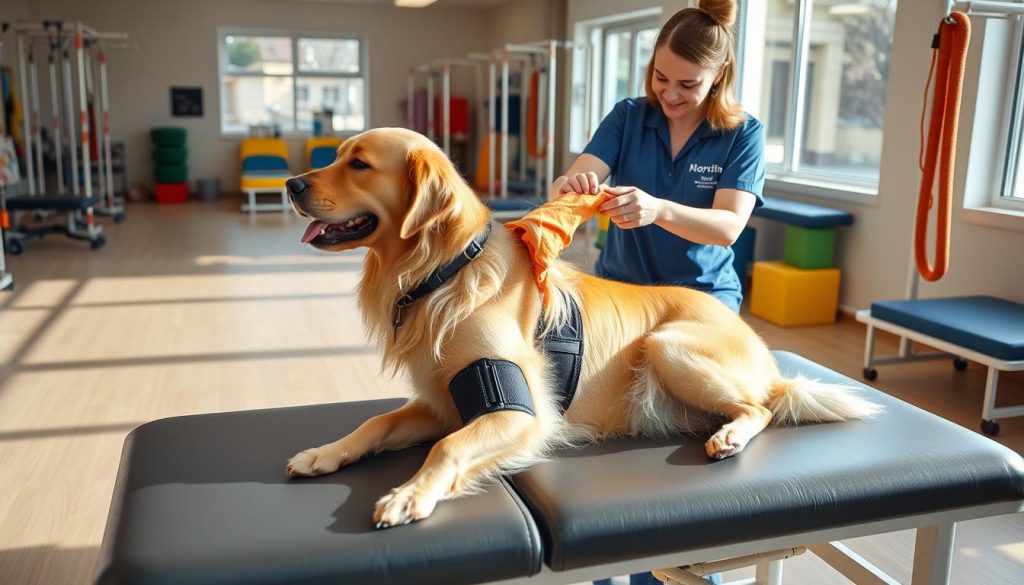
Dogs get treatment plans made just for them at these centers. They use cool stuff like underwater treadmills for exercise. This way, dogs can move without hurting their joints.
Therapists do things like manual therapy and strength training to help dogs heal faster. This helps dogs get better quicker and feel better in the long run.
“Specialized physical therapy can significantly improve a dog’s recovery after knee surgery, often reducing pain and increasing mobility faster than traditional methods.”
These centers also offer extra help like nutrition advice and pain management. They look at all parts of a dog’s health to help them heal best after surgery.
Essential Equipment in Canine Rehabilitation Facilities
Veterinary rehabilitation facilities have special tools to help dogs heal from knee surgeries. These tools are key for pet physiotherapy for knee injuries. They make sure dogs recover safely and effectively.
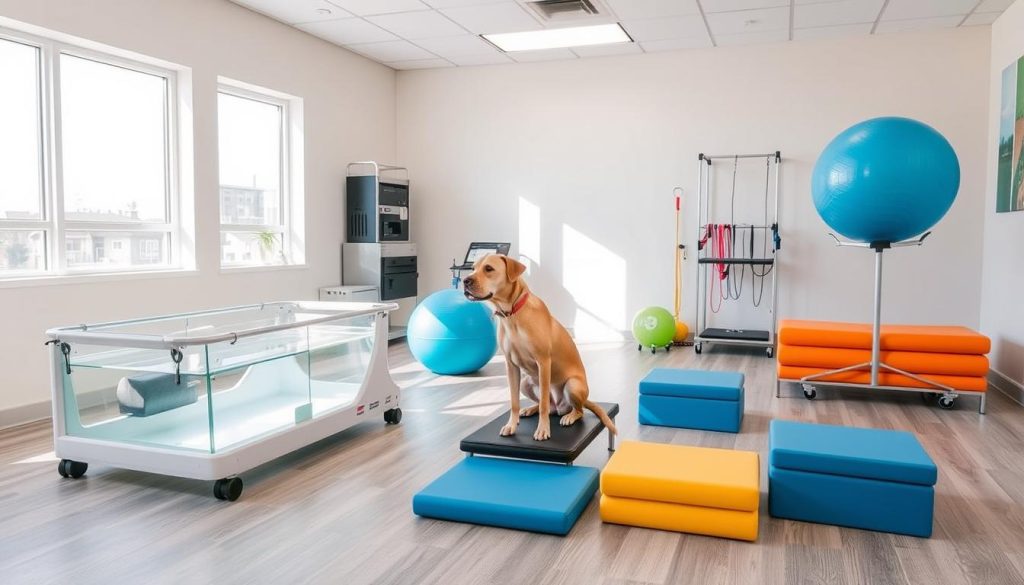
Underwater Treadmills and Hydrotherapy Pools
Underwater treadmills are a big part of canine rehab. Dogs walk on a treadmill in water, which eases the stress on their joints. This low-impact exercise helps build muscle and improve movement.
Hydrotherapy pools offer another water-based option. Dogs swim or do exercises in warm water. This helps with healing and strengthening without putting too much stress on their knees.
Therapeutic Laser Equipment
Laser therapy is becoming more popular in pet physiotherapy for knee injuries. It uses light energy to help cells heal and increase blood flow. This treatment is non-invasive and can reduce pain and swelling, helping dogs heal faster.
Balance and Proprioception Tools
Balance boards, wobble cushions, and obstacle courses are vital for a dog’s coordination and joint awareness. These tools challenge a dog’s balance. They help strengthen the muscles around the knee joint.
| Equipment | Benefits |
|---|---|
| Underwater Treadmill | Low-impact exercise, muscle strengthening |
| Therapeutic Laser | Pain reduction, tissue healing |
| Balance Tools | Improved coordination, joint stability |
With this range of specialized equipment, veterinary rehabilitation facilities can offer full care for dogs after knee surgeries. This ensures a quicker and more complete recovery.
Specialized Treatment Techniques in Dog Physical Therapy
Dog knee surgery recovery centers use many special treatments. These help improve mobility, reduce pain, and get function back after surgery.
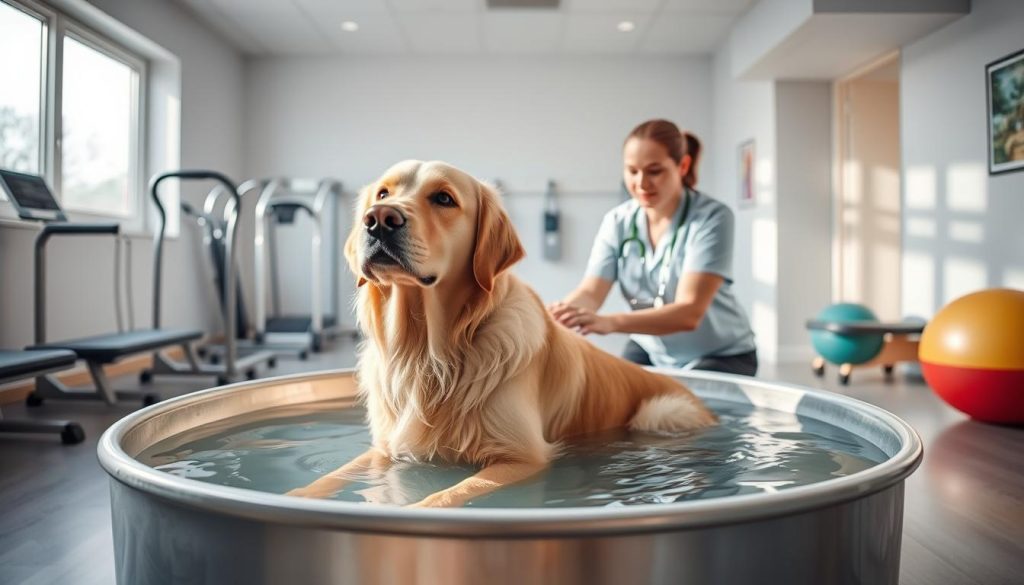
Manual therapies are key in recovery. Joint mobilization increases knee range and flexibility. Massage therapy cuts down muscle tension and boosts blood flow, speeding healing.
Therapeutic exercises are the core of rehab programs. They strengthen knee muscles, improve balance, and boost mobility. Each dog gets a plan tailored to their needs and recovery stage.
Pain management is vital in rehab. Dog knee surgery recovery centers use ultrasound and electrical stimulation. These methods reduce pain and help tissues heal, making rehab more effective.
| Treatment Technique | Benefits | Frequency |
|---|---|---|
| Joint Mobilization | Improves range of motion | 2-3 times per week |
| Massage Therapy | Reduces muscle tension | 1-2 times per week |
| Therapeutic Exercises | Strengthens muscles, improves balance | Daily |
| Ultrasound Therapy | Promotes tissue healing | 2-3 times per week |
| Electrical Stimulation | Manages pain, stimulates muscles | 2-3 times per week |
Canine orthopedic rehab centers mix these techniques for a full treatment plan. This approach aims for the best results for dogs after knee surgery.
Selecting the Right Rehabilitation Center for Your Dog
Choosing the right physical therapy center for your dog after knee surgery is key. A great facility can greatly improve your dog’s recovery.
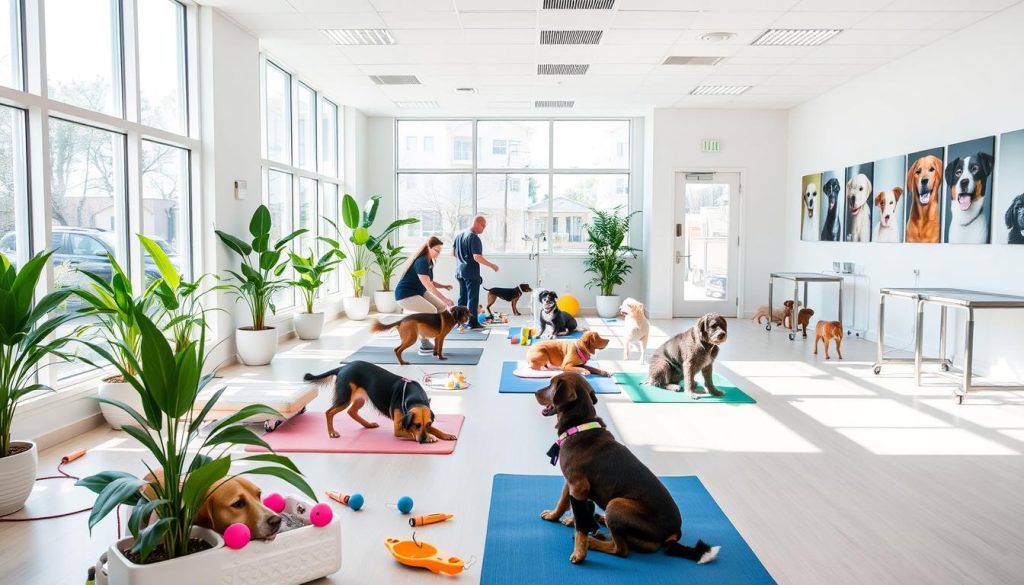
Facility Certification Requirements
Look for canine rehabilitation clinics with recognized certifications. These might include the American Association of Rehabilitation Veterinarians (AARV) or the Canine Rehabilitation Institute (CRI). Certified places usually have higher care standards and use the latest treatments.
Staff Qualifications and Experience
The staff’s expertise is very important. Find centers with certified canine rehabilitation practitioners (CCRPs) or vets with rehab training. Experienced staff can create treatment plans that fit your dog’s needs.
Available Treatment Options
A wide range of treatments is vital for effective rehab. Look for centers that offer:
- Hydrotherapy
- Manual therapy
- Therapeutic exercises
- Laser therapy
- Electrical stimulation
| Treatment | Benefits | Frequency |
|---|---|---|
| Hydrotherapy | Low-impact exercise, improved circulation | 2-3 times per week |
| Manual Therapy | Increased flexibility, pain reduction | 1-2 times per week |
| Laser Therapy | Reduced inflammation, faster healing | 3-5 times per week |
By looking at these points, you can find a rehab center that meets your dog’s post-surgery needs.
Benefits of Professional Canine Physical Therapy
Professional canine physical therapy has many benefits for dogs after knee surgery. It helps them heal faster and improves their overall health. Dogs in these programs often recover quicker and move better.
One big advantage of dog ACL surgery recovery through therapy is less chance of getting hurt again. Trained therapists teach dogs exercises to strengthen the muscles around the joint. This makes the joint more stable and prevents future problems.
Physical therapy also helps with the emotional side of healing. Dogs can feel stressed and anxious while they’re recovering. Regular therapy sessions can make them feel better and more confident.
“Professional physical therapy is essential for optimal recovery after canine knee surgery. It not only aids in physical healing but also supports the dog’s mental health throughout the process.”
The benefits of pet orthopedic physical therapy last long after recovery. Dogs who go through a full rehab program often move better and live better lives. They can be more active and stay healthier for years after surgery.
- Faster recovery times
- Improved joint mobility
- Reduced risk of re-injury
- Enhanced psychological well-being
- Better long-term outcomes
By choosing professional canine physical therapy, pet owners give their dogs the best care during recovery. This ensures they get the support they need to heal well.
Cost Considerations for Dog Knee Surgery Recovery
Recovering from dog knee surgery can be pricey. But, it’s key for your dog’s full recovery. Knowing the costs and options can help make this treatment easier to handle.
Insurance Coverage Options
Pet insurance can cut down on costs for dog knee surgery recovery. Many policies cover physical therapy and rehab. It’s wise to check your policy or get one before surgery. Some plans might have waiting periods or exclude pre-existing conditions.
| Insurance Type | Coverage for Knee Surgery | Coverage for Physical Therapy |
|---|---|---|
| Basic Plan | Partial | Limited |
| Comprehensive Plan | Full | Extended |
| Wellness Plan | None | Preventive care only |
Payment Plans and Financial Assistance
Vets and rehab centers often have payment plans. These plans help spread out the cost of recovery. Some places work with financing companies for low-interest or no-interest options. Pet credit cards can also help manage expenses.
If money is tight, there are charities that help with vet bills. These groups offer grants or low-cost services. Look into local and national options for support during your dog’s recovery.
At-Home Care During Physical Therapy Treatment
Recovering from knee surgery needs teamwork between pet physiotherapy and home care. It’s important to make your home safe. Remove slippery rugs and block stairs to prevent falls. Use non-slip mats and make your dog’s bed easy to get to and comfy.
At home, you can do gentle exercises with your dog. These might include:
- Passive range of motion movements
- Controlled leash walks
- Balance exercises on firm surfaces
Always listen to your therapist to avoid too much exercise.
Good food is key for recovery. Feed a balanced diet with lots of proteins and omega-3s. Keep your dog’s weight in check to ease stress on their joints. Make sure they get plenty of rest between therapy and exercises.
Track your dog’s progress with this simple chart:
| Week | Daily Exercise Time | Pain Level (1-10) | Mobility Progress |
|---|---|---|---|
| 1 | 5-10 minutes | 7-8 | Limited |
| 2 | 10-15 minutes | 5-6 | Slight improvement |
| 3 | 15-20 minutes | 3-4 | Noticeable progress |
| 4 | 20-30 minutes | 1-2 | Significant improvement |
Talking often with your vet helps make sure your home care matches their treatment plans. This helps your dog recover better.
Recovery Milestones and Progress Tracking
It’s important to track how well a dog recovers after knee surgery. Dog knee surgery recovery centers use different ways to check on healing. They look at physical health, how well the dog moves, and manage pain to help with recovery.
Physical Assessment Markers
Vets and therapists check how well the joints move and muscle strength. They use special tools to keep track of these signs over time. This helps them make the right changes to the dog’s recovery plan.
Mobility Improvement Indicators
Pet owners notice when their dog starts moving better at home. Signs of getting better include:
- More weight on the affected leg
- Better walking and balance
- Easier climbing stairs or jumping
- Doing daily tasks more easily
Sharing these changes with the rehab team helps make the recovery plan even better.
Pain Management Progress
Managing pain is a big part of helping dogs recover from knee surgery. Experts watch pain levels by:
- Physical checks
- Watching how the dog acts and moves
- Changing meds as needed
When pain goes down, dogs are more ready to do therapy exercises. This shows they’re getting better.
By keeping an eye on these key points, dog knee surgery recovery centers can give each dog the best care. This helps them recover as well as possible.
Integrated Rehabilitation Programs
Physical therapy centers for dogs after knee surgery offer complete care through integrated programs. These programs mix different treatments to cover all healing aspects. This ensures a full recovery approach.
Canine rehabilitation clinics make these programs fit each dog’s needs. They consider age, breed, and health. This way, vets can work on pain, muscle, and joint health together.
A typical program might include:
- Hydrotherapy sessions
- Laser therapy treatments
- Manual therapy techniques
- Therapeutic exercises
- Nutritional guidance
This multi-faceted approach helps dogs recover faster and better. Dogs in these programs often move and get stronger quicker than those with single treatments.
Owners are key in these programs. They learn to do exercises at home and watch their pet’s progress. This teamwork between vets and owners keeps care consistent during recovery.
As research in canine rehab grows, therapy centers keep improving their programs. This ongoing improvement ensures top care for our furry friends.
Alternative Therapies in Canine Knee Recovery
Dog ACL surgery recovery can be improved with alternative therapies. These treatments work alongside traditional pet orthopedic physical therapy. They offer more pain relief and healing support. Let’s look at some effective options for your furry friend’s knee recovery.
Acupuncture Benefits
Acupuncture uses specific points on a dog’s body to promote healing. This ancient practice can reduce pain, improve circulation, and speed up recovery after knee surgery. Many dogs find acupuncture relaxing, making it a stress-free addition to their rehabilitation plan.
Massage Therapy Options
Massage therapy is key in dog ACL surgery recovery. It reduces swelling, eases muscle tension, and improves blood flow to the affected area. Gentle strokes and kneading techniques can be applied to promote healing and comfort during the recovery process.
Cold and Heat Therapy
Cold and heat therapy are valuable tools in pet orthopedic physical therapy. Cold packs help reduce inflammation in the early stages of recovery. Heat therapy can be introduced later to relax muscles and increase flexibility. These treatments can be easily administered at home under professional guidance.
| Therapy Type | Benefits | When to Use |
|---|---|---|
| Acupuncture | Pain relief, improved circulation | Throughout recovery |
| Massage | Reduced swelling, muscle relaxation | After initial healing |
| Cold Therapy | Decreased inflammation | First 48-72 hours post-surgery |
| Heat Therapy | Increased flexibility, muscle relaxation | Later stages of recovery |
Duration of Physical Therapy Programs
Post-operative knee therapy for dogs can last different lengths of time. Several factors influence this, including the surgery type, your dog’s age, health, and any complications.
Most dog knee injury recovery programs last 8 to 12 weeks. This time allows for healing and strengthening of the affected limb. Dogs with complex surgeries or pre-existing conditions might need longer therapy.
The first part of recovery focuses on managing pain and controlled movement. As your dog gets better, the therapy gets tougher. It’s key to finish the whole program for the best results.
| Recovery Phase | Duration | Focus |
|---|---|---|
| Immediate Post-Surgery | 1-2 weeks | Pain management, rest |
| Early Rehabilitation | 2-4 weeks | Gentle exercises, range of motion |
| Progressive Strengthening | 4-8 weeks | Increased activity, balance training |
| Return to Function | 8-12 weeks | Advanced exercises, normal activity resumption |
Every dog’s recovery is different. Your vet and physical therapist will make a custom plan for your pet. This ensures the best outcome for their knee injury recovery.
Success Stories and Recovery Outcomes
Veterinary rehabilitation centers have changed many dogs’ lives after knee surgeries. They offer special pet physiotherapy for knee injuries. This helps our furry friends move better and feel more alive.
Max, a Labrador Retriever, had cruciate ligament surgery. After six weeks of therapy, he could use his leg fully. His owner said, “Max is back to his old self, playing and chasing balls again.”
Bella, a senior Beagle, got therapy for her knee injuries after surgery. The therapists made a plan with underwater treadmill sessions and specific exercises. In three months, Bella could climb stairs and go on long walks.
These stories show how well professional rehabilitation works. Dogs in these programs often see:
- More mobility and flexibility
- Less pain and discomfort
- Stronger muscles and more stable joints
- A better quality of life
Veterinary rehabilitation centers help dogs physically and emotionally. They support pets and their owners during tough times after surgery. The good results from these centers show the value of professional care. It helps our dogs live happy, active lives again.
Preventing Future Knee Injuries
After your dog has knee surgery, it’s key to prevent future injuries. Dog knee surgery recovery centers and canine orthopedic rehabilitation facilities offer advice on long-term care. They focus on keeping joints healthy and avoiding re-injury.
Exercise Modifications
Changing your dog’s exercise routine is vital for knee protection. Specialists suggest low-impact activities like swimming and controlled leash walks. These exercises build muscle without harming the joints.
Weight Management Strategies
Keeping your dog at a healthy weight is essential for knee health. Dog knee surgery recovery centers provide nutritional advice. A balanced diet and portion control help manage your dog’s weight, easing joint stress.
| Weight Management Tips | Benefits |
|---|---|
| Measure food portions | Prevents overfeeding |
| Choose low-calorie treats | Reduces unnecessary weight gain |
| Regular weigh-ins | Monitors progress effectively |
Ongoing Maintenance Therapy
Continuous care is key for long-term joint health. Canine orthopedic rehabilitation programs include regular check-ups and exercises. These sessions spot issues early and keep muscles strong, ensuring your dog’s knee stays healthy after recovery.
Latest Advances in Canine Physical Therapy
The field of canine rehabilitation is growing fast, bringing new hope to dogs after knee surgery. Physical therapy centers for dogs after knee surgery are using new technologies to help them recover better.
Shockwave therapy is becoming popular in canine rehabilitation clinics. It’s a non-invasive treatment that uses pressure waves to help healing, reduce pain, and improve movement in dogs after knee surgery. Many centers now offer this innovative therapy as part of their rehabilitation programs.
Regenerative medicine is another big step forward in canine physical therapy. Treatments like stem cell therapy and platelet-rich plasma injections are showing great promise. They help speed up healing and reduce inflammation after knee surgery. These therapies use the body’s natural healing processes to potentially shorten recovery times.
Laser therapy has also seen big improvements. New cold laser devices can penetrate deeper into tissues, helping with faster healing and pain relief. This treatment is becoming a key part of many physical therapy centers for dogs after knee surgery.
Research in canine biomechanics is changing how we approach rehabilitation. Gait analysis technology lets therapists tailor treatment plans based on a dog’s movement patterns. This data-driven approach makes therapy sessions more targeted and effective.
As these advancements keep growing, dogs recovering from knee surgery can look forward to faster, more comfortable, and more effective rehabilitation. They’ll get the best care at specialized canine rehabilitation clinics.
Working with Your Veterinarian and Physical Therapist
Teamwork is key in dog ACL surgery recovery. Pet owners, vets, and physical therapists must join forces to ensure the best outcome. Regular check-ins and open communication are vital throughout the healing process.
During appointments, don’t hesitate to ask questions about your pet’s progress. Share any concerns or changes you’ve noticed at home. This information helps your healthcare team adjust the treatment plan as needed for optimal results in pet orthopedic physical therapy.
Follow-up visits play a big role in monitoring long-term recovery. These appointments allow your vet and physical therapist to assess your dog’s improvement. They can make necessary tweaks to the rehabilitation program. By working closely with your pet’s care team, you’ll give your furry friend the best chance at a full and speedy recovery.
FAQ
Q: What are the most common types of knee surgeries performed on dogs?
A: Dogs often get knee surgeries for ACL tears and patellar luxation. These surgeries help dogs move better and live happier lives.
Q: How long does the recovery process typically take after a dog’s knee surgery?
A: Recovery time after knee surgery for dogs varies. It usually takes 8-12 weeks for basic recovery. Full recovery might take 3-6 months, depending on the surgery, the dog’s health, and how well they follow the rehab plan.
Q: What specialized equipment is used in canine rehabilitation facilities?
A: Facilities use special tools like underwater treadmills and hydrotherapy pools. They also have laser therapy and tools for balance and proprioception. These help strengthen muscles, improve movement, and ease stress on joints.
Q: How do I choose the right rehabilitation center for my dog?
A: Look for a center with certifications and skilled staff. Make sure they offer a variety of therapies for knee care. Certified practitioners and a wide range of treatments are key.
Q: Are there any alternative therapies that can complement traditional physical therapy for dogs?
A: Yes, therapies like acupuncture and massage can help. Cold/heat therapy also aids in pain relief and healing. These methods work well with traditional therapy to improve recovery.
Q: How can I prevent future knee injuries in my dog after surgery and rehabilitation?
A: Keep your dog at a healthy weight and adjust their exercise. Consider ongoing therapy to prevent injuries. Regular vet visits and following care instructions are also important.
Q: What are some signs of progress during my dog’s recovery from knee surgery?
A: Look for signs like better weight-bearing and more movement. Reduced pain and discomfort are also good signs. Your physical therapist will track these signs closely.
Q: How often should my dog attend physical therapy sessions after knee surgery?
A: Sessions may start at 2-3 times a week. This can decrease as your dog gets better. Your vet and physical therapist will plan the best schedule for your dog.
Q: What role do I play in my dog’s recovery at home?
A: You’re key to your dog’s recovery at home. Create a safe space, help with exercises, and ensure rest and nutrition. Follow your vet’s and physical therapist’s advice closely.
Q: Are there any recent advancements in canine physical therapy for knee surgery recovery?
A: Yes, new methods like shockwave therapy and regenerative medicine are being used. Advanced underwater treadmills are also part of the latest treatments. Research is always improving recovery options for dogs.












